Effect of Internal Waves on the Hydrodynamics of a Mediterranean Sea Strait
Abstract
:1. Introduction
1.1. Area of Interest and Available Studies
1.2. Wind Field Characteristics in the Wider Area of the Strait
2. Methodology
2.1. Hydrodynamic Formulation
2.2. Computational Domain, Boundary, and Initial Conditions
3. Results and Discussion
3.1. Brief Presentation of Hydrodynamic Circulation in the Wider Area of the Rio-Antirio Strait
3.2. Generation and Action of Internal Waves in the Rio-Antirio Strait
3.2.1. Wind-Induced Circulation
3.2.2. Tide-Induced Circulation
3.3. Interplay of Coriolis Effect and Internal Waves
3.4. The Structure of Turbulence in the Strait
3.4.1. Wind-Induced Flow
3.4.2. Tide-Induced Flow
4. Conclusions
- Stratification plays an important role in the hydrodynamics of the strait, which leads to the generation of internal waves, locally affecting the structure of the flow;
- Wind-induced circulation has a critical effect in the wider area of the strait, causing strong wind-induced currents at the upper layer of the epilimnion. The action of internal waves causes strong subsurface currents’ “pumping” of water from the deeper and colder gulf into the shallower one. On the free surface, the direction of the flow is driven by the wind action;
- For winds blowing from the eastern sector, there is no net reverse flow in the strait water column under the effect of internal waves. In these cases, the motion of the internal waves facilitates the wind-induced flow in the strait, as well as the magnitude of the hypolimnetic flow velocity. On the contrary, for winds covering the western sector, the generation of internal waves leads to a purely reverse flow in the strait area, since their motion opposes the dominant wind-induced flow in the strait;
- Tide-induced internal waves marginally affect the exchange flowrate in the Rio–Antirio strait. Under the tidal action, strong currents in the order of 1 m/s are generated at the upper layer of the epilimnion, while the effect of internal wave leads to the formation of subsurface currents with the opposite direction compared to the principal tidal direction of the flow in the strait. These currents also carry colder waters from the deeper gulf to the warmer one;
- Turbulence structure was estimated to be substantially affected by the action of internal waves in the strait. For the wind-induced flow, the action of internal waves leads to a bottom generated turbulence. For the tidal flow, the tide-generated turbulence is restricted within the hypolimnion. In all the cases examined, the wind generated turbulence is restricted within the epilimnion;
- Under the influence of internal waves, the spatially varying current field in the strait reveals strong bottom currents, which in turn could be related to transport as well as dispersive phenomena in the vicinity of the strait.
Funding
Institutional Review Board Statement
Informed Consent Statement
Data Availability Statement
Acknowledgments
Conflicts of Interest
References
- Al Senafi, F.; Anis, A. Internal waves on the continental shelf of the Northwestern Arabian Gulf. Front. Mar. Sci. 2020, 6, 805. [Google Scholar] [CrossRef]
- Holloway, P.E. Internal hydraulic jumps and solitons at a shelf break region on the Australian North West Shelf. J. Geophys. Res. Ocean. 1987, 92, 5405–5416. [Google Scholar]
- Von Arx, W.S. An Introduction to Physical Oceanography; Addison-Wesley Publishing Company, Inc.: Boston, MA, USA, 1962; 422p. [Google Scholar]
- Defant, A. Physical Oceanography; Pergamon Press: New York, NY, USA, 1961; Volume 2, 598p. [Google Scholar]
- Leder, N. Wind-induced internal wave dynamics near the Adriatic shelf break. Cont. Shelf Res. 2002, 22, 445–463. [Google Scholar] [CrossRef]
- Waterhouse, A.F.; MacKinnon, J.A.; Nash, J.D.; Alford, M.H.; Kunze, E.; Simmons, H.L.; Polzin, K.L.; Laurent, L.C.S.; Sun, O.M.; Pinkel, R.; et al. Global patterns of diapycnal mixing from measurements of the turbulent dissipation rate. J. Phys. Oceanogr. 2014, 44, 1854–1872. [Google Scholar] [CrossRef]
- Legg, S.; Klymak, J. Internal hydraulic jumps and overturning generated by tidal flow over a tall steep ridge. J. Phys. Oceanogr. 2008, 38, 1949–1964. [Google Scholar] [CrossRef]
- Apel, J.R. Oceanic Internal Waves and Solitons. An Atlas of Oceanic Internal Solitary Waves. 2020, Volume 1, pp. 1–40. Available online: https://www.internalwaveatlas.com/Atlas2_PDF/IWAtlas_Pg001_Background&Theory.pdf (accessed on 22 January 2024).
- Laurent, L.S.; Alford, M.H.; Paluszkiewicz, T. An introduction to the special issue on internal waves. Oceanography 2012, 25, 15–19. [Google Scholar] [CrossRef]
- Baines, P.G. Topographic Effects in Stratified Flows; Cambridge University Press: Cambridge, MA, USA, 1998; 500p. [Google Scholar]
- Massel, S.R. Internal Gravity Waves in the Shallow Seas; Springer International Publishing: Berlin/Heidelberg, Germany, 2015. [Google Scholar]
- Benilov, A.Y.; Solntseva, N.I.; Filyushkin, B.N. Relationship between the variability of the wind field and internal waves. Oceanology 1978, 18, 257–266. [Google Scholar]
- LeBlond, P.H.; Mysak, L.A. Waves in the Ocean; Elsevier: Amsterdam, The Netherlands, 1981. [Google Scholar]
- Morozov, E.G. Oceanic Internal Tides: Observations, Analysis and Modeling. A Global View; Springer: Cham, Switzerland, 2018; 304p. [Google Scholar] [CrossRef]
- Koohestani, K.; Stepanyants, Y.; Allahdadi, M.N. Analysis of Internal Solitary Waves in the Gulf of Oman and Sources Responsible for Their Generation. Water 2023, 15, 746. [Google Scholar] [CrossRef]
- Wang, C.; Wang, X.; Da Silva, J.C. Studies of internal waves in the strait of Georgia based on remote sensing images. Remote Sens. 2019, 11, 96. [Google Scholar] [CrossRef]
- Khimchenko, E.E.; Frey, D.I.; Morozov, E.G. Tidal internal waves in the Bransfield Strait, Antarctica. Russ. J. Earth Sci. 2020, 20, 6. [Google Scholar] [CrossRef]
- Purwandana, A.; Edikusmanto, E.; Utari, P.A.; Lestiana, H.; Saputra, O.F.; Sari, Q.W. Observation of Internal Solitary Waves near Its Generation Site in the Lombok Strait, Indonesia. Positron 2023, 13, 95–103. [Google Scholar] [CrossRef]
- Brandt, P.; Rubino, A.; Quadfasel, D.; Alpers, W.; Sellschopp, J.; Fiekas, H.V. Evidence for the influence of Atlantic-Ionian Stream fluctuations on the tidally induced internal dynamics in the Strait of Messina. J. Phys. Oceanogr. 1999, 29, 1071–1080. [Google Scholar] [CrossRef]
- Vlasenko, V.; Brandt, P.; Rubino, A. Structure of large-amplitude internal solitary waves. J. Phys. Oceanogr. 2000, 30, 2172–2185. [Google Scholar] [CrossRef]
- Sangra, P.; Basterretxea, G.; Pelegri, J.L.; Aristegui, J. Chlorophyll increase due to interna1 waves on the shelf break of Gran Canaria (Canary Islands). Sci. Mar. 2001, 65 (Suppl. S1), 89–97. [Google Scholar] [CrossRef]
- Rinke, K.; Bner, I.H.; Petzoldt, T.; Rolinski, S.; Nig-Rinke, M.K.; Post, J.; Lorke, A.; Benndorf, J.R. How internal waves influence the vertical distribution of zooplankton. Freshw. Biol. 2007, 52, 137–144. [Google Scholar] [CrossRef]
- Garwood, J.C.; Musgrave, R.C.; Lucas, A.J. Life in Internal Waves. Oceanography 2020, 33, 38–49. [Google Scholar] [CrossRef]
- Ziegenbein, J. Short internal waves in the Strait of Gibraltar. Deep Sea Res. Oceanogr. Abstr. 1969, 16, 479–487. [Google Scholar] [CrossRef]
- Boyce, F.M. Internal waves in the Straits of Gibraltar. Deep Sea Res. Oceanogr. Abstr. 1975, 22, 597–610. [Google Scholar] [CrossRef]
- Watson, G.; Robinson, I.S. A study of internal wave propagation in the Strait of Gibraltar using shore-based marine radar images. J. Phys. Oceanogr. 1990, 20, 374–395. [Google Scholar] [CrossRef]
- Pistek, P.; La Violette, P.E. Observations of the suppression of tide-generated nonlinear internal wave packets in the Strait of Gibraltar. J. Mar. Syst. 1999, 20, 113–128. [Google Scholar] [CrossRef]
- Morozov, E.G.; Trulsen, K.; Velarde, M.G.; Vlasenko, V.I. Internal tides in the Strait of Gibraltar. J. Phys. Oceanogr. 2002, 32, 3193–3206. [Google Scholar] [CrossRef]
- Vázquez, A.; Bruno, M.; Izquierdo, A.; Macías, D.; Ruiz-Cañavate, A. Meteorologically forced subinertial flows and internal wave generation at the main sill of the Strait of Gibraltar. Deep Sea Res. Part I Oceanogr. Res. Pap. 2008, 55, 1277–1283. [Google Scholar] [CrossRef]
- Griffa, A.; Marullo, S.; Santoleri, R.; Viola, A. Internal nonlinear tidal waves generated at the Strait of Messina. Cont. Shelf Res. 1986, 6, 677–687. [Google Scholar] [CrossRef]
- Sapia, A.; Salusti, E. Observation of nonlinear internal solitary wave trains at the northern and southern mouths of the Strait of Messina. Deep Sea Res. Part A. Oceanogr. Res. Pap. 1987, 34, 1081–1092. [Google Scholar] [CrossRef]
- Alpers, W.; Brandt, P.; Rubino, A.; Backhaus, J.O. Recent contributions of remote sensing to the study of internal waves in the straits of Gibraltar and Messina. Bull. -Inst. Oceanogr. Monaco-Numero Spec. 1996, 17, 21–40. [Google Scholar]
- Brandt, P.; Rubino, A.; Alpers, W.; Backhaus, J.O. Internal waves in the Strait of Messina studied by a numerical model and synthetic aperture radar images from the ERS 1/2 satellites. J. Phys. Oceanogr. 1997, 27, 648–663. [Google Scholar] [CrossRef]
- Casagrande, G.; Varnas, A.W.; Stéphan, Y.; Folégot, T. Genesis of the coupling of internal wave modes in the Strait of Messina. J. Mar. Syst. 2009, 78, S191–S204. [Google Scholar] [CrossRef]
- Droghei, R.; Falcini, F.; Casalbore, D.; Martorelli, E.; Mosetti, R.; Sannino, G.; Santoleri, R.; Chiocci, F.L. The role of Internal Solitary Waves on deep-water sedimentary processes: The case of up-slope migrating sediment waves off the Messina Strait. Sci. Rep. 2016, 6, 36376. [Google Scholar] [CrossRef] [PubMed]
- Oddo, P.; Poulain, P.M.; Falchetti, S.; Storto, A.; Zappa, G. Internal tides in the central Mediterranean Sea: Observational evidence and numerical studies. Ocean Dyn. 2023, 73, 145–163. [Google Scholar] [CrossRef]
- Drakopoulos, P.G.; Lascaratos, A. A preliminary study on the internal tides of the gulfs of Patras and Korinthos, Greece. Cont. Shelf Res. 1998, 18, 1517–1529. [Google Scholar] [CrossRef]
- Rubi, R.; Hubert-Ferrari, A.; Fakiris, E.; Christodoulou, D.; Dimas, X.; Geraga, M.; Papatheodorou, G.; Caterina, B. Hydrodynamics and sedimentary processes in the modern Rion strait (Greece): Interplay between tidal currents and internal tides. Mar. Geol. 2022, 446, 106771. [Google Scholar] [CrossRef]
- Google Earth Pro, Version 7.3.6.9345. Available online: https://www.google.com/earth/versions/#earth-pro (accessed on 22 January 2024).
- Papailiou, D.D. Oceanographical Study in Patras Gulf Waters for Pollution Management; Department of Mechanical Engineering, University of Patras: Patras, Greece, 1982; Volume II. (In Greek) [Google Scholar]
- Friligos, N.; Theoharis, A.; Georgopoulos, D. Preliminary chemical and physical observations during summer 1980 on a silled embayment in the Ionian Sea. Vie Et Milieu 1985, 35, 115–125. [Google Scholar]
- Lascaratos, A.; Salusti, E.; Papageorgaki, G. Wind-induced upwellings and currents in the gulfs of Patras, Nafpaktos and Korinthos, Western Greece. Oceanol. Acta 1989, 12, 159–164. [Google Scholar]
- Poulos, S.E.; Collins, M.B.; Pattiaratchi, C.; Cramp, A.; Gull, W.; Tsimplis, M.; Papatheodorou, G. Oceanography and sedimentation in the semi-enclosed, deep-water Gulf of Corinth (Greece). Mar. Geol. 1996, 134, 213–235. [Google Scholar] [CrossRef]
- Hadjitheodorou, C.; Antonopoulos, I. Investigation and Analysis of Stability and Mechanical Behaviour of the Coastal Zone in the Area of Rion Antirion; Final Report; Department of Civil Engineering, University of Patras: Patras, Greece, 1989. [Google Scholar]
- Antonopoulos, J.; Ilias, D.; Papageorgiou, K.; Ahmed, S. Investigation of the Anemological Field in the Area of Rio-Antirio for the Bridging Project; Final Report, Ministry of Environment, Physical Planning and Public Works Directorate D1; University of Patras, Department of Civil Engineering: Patras, Greece, 1992. (In Greek) [Google Scholar]
- Antonopoulos, J.; Grigoropoulos, S.; Tsonis, S.; Yannopoulos, P. Research Investigation of Physical-Chemical Parameters of Seawater and Its Biological Pollution Potential on Underwater Construction in the Area of Rio-Antirio for the Bridge Project; Final Report: 1. Physical-Chemical Parameters of Seawater, Ministry of Environment, Physical Planning and Public Works-Directorate D1; University of Patras, Department of Civil Engineering: Patras, Greece, 1992. (In Greek) [Google Scholar]
- Hadjitheodorou, C.; Antonopoulos, J.; Lascaratos, A.; Papageorgiou, E.; Papageorgiou, K.; Trova, E. Investigation of the Sea Currents in the Area of Rio-Antirio for the Bridging Project; Final Report, Ministry of Environment, Physical Planing and Public Works-Directorate D1; University of Patras, Department of Civil Engineering: Patras, Greece, 1992. (In Greek) [Google Scholar]
- Fourniotis, N.T. Three-Dimensional Numerical Simulation of the Hydrodynamic Circulation in the Gulf of Patras, with Emphasis on the Currents in the Coastal Zone of the Port of Patras. Ph.D. Thesis, Department of Civil Engineering, University of Patras, Patras, Greece, 2009. (In Greek). [Google Scholar]
- Fourniotis, N.T.; Horsch, G.M. Three-dimensional numerical simulation of wind-induced barotropic circulation in the Gulf of Patras. Ocean Eng. 2010, 37, 355–364. [Google Scholar] [CrossRef]
- Fourniotis, N.T.; Horsch, G.M. Baroclinic circulation in the Gulf of Patras (Greece). Ocean Eng. 2015, 104, 238–248. [Google Scholar] [CrossRef]
- Horsch, G.M.; Fourniotis, N.T. Wintertime Tidal Hydrodynamics in the Gulf of Patras, Greece. J. Coast. Res. 2017, 33, 1305–1314. [Google Scholar] [CrossRef]
- Achilleopoulos, P. Tides in Gulfs and Straits of Western Greece. Ph.D. Thesis, University of Patras, Department of Geology, Patras, Greece, 1990; 265p. (In Greek). [Google Scholar]
- DHI Water and Environment. MIKE 3 Flow Model FM, Hydrodynamic Module; User Guide; DHI: Singapore, 2023; p. 158. [Google Scholar]
- Smagorinsky, J. General circulation experiments with the primitive equations I. The basic experiment. Mon. Weather Rev. 1963, 91, 99–165. [Google Scholar] [CrossRef]
- Rodi, W. Turbulence Models and Their Applications in Hydraulics; IAHR: Delft, The Netherlands, 1984. [Google Scholar]
- Roe, P.L. Approximate Riemann solvers, parameter vectors and difference-schemes. J. Comput. Phys. 1981, 43, 357–372. [Google Scholar] [CrossRef]
- Fourniotis, N.T. Erosion of the Thermocline in the Gulf of Patras, due to a Severe Wind event. Glob. Nest J. 2018, 20, 136–146. [Google Scholar]
- Wadzuk, B.M.; Hodges, B.R. Comparing hydrostatic and non-hydrostatic Navier Stokes models of internal waves. In Proceedings of the 16th ASCE Engineering Mechanics Conference, Seattle, WA, USA, 16–18 July 2003; Electronic Proceedings; University of Washington: Seattle, WA, USA; 4p.
- Hodges, B.R.; Laval, B.; Wadzuk, B.M. Numerical error assessment and a temporal horizon for internal waves in a hydrostatic model. Ocean Model. 2006, 13, 44–64. [Google Scholar] [CrossRef]
- Wadzuk, B.M.; and Hodges, B.R. Hydrostatic versus Nonhydrostatic Euler-Equation Modeling of Nonlinear Internal Waves. J. Eng. Mech. 2009, 135, 1069–1080. [Google Scholar] [CrossRef]
- Álvarez, Ó.; Izquierdo, A.; González, C.J.; Bruno, M.; Mañanes, R. Some considerations about non-hydrostatic vs. hydrostatic simulation of short-period internal waves. A case study: The Strait of Gibraltar. Cont. Shelf Res. 2019, 181, 174–186. [Google Scholar] [CrossRef]
- Zamani, B.; Koch, M. Comparison between two hydrodynamic models in simulating physical processes of a reservoir with complex morphology: Maroon Reservoir. Water 2020, 12, 814. [Google Scholar] [CrossRef]
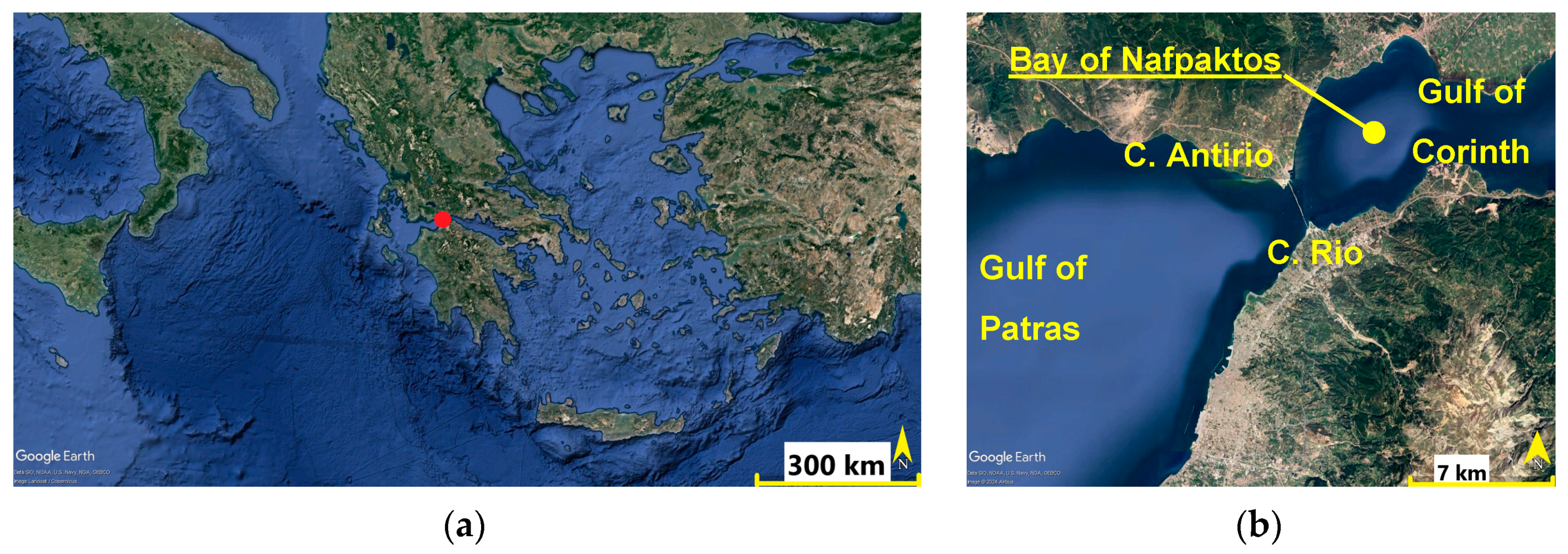
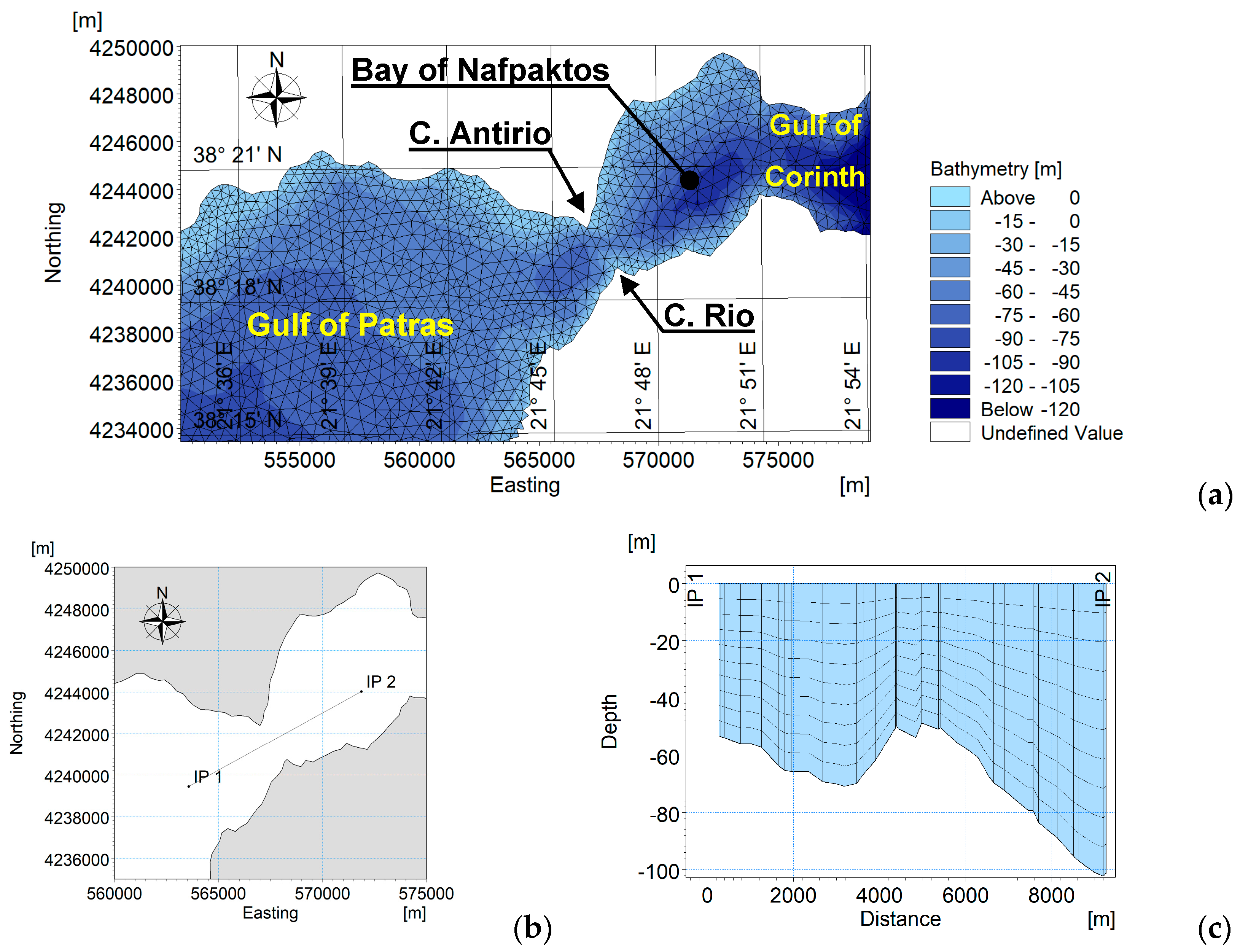
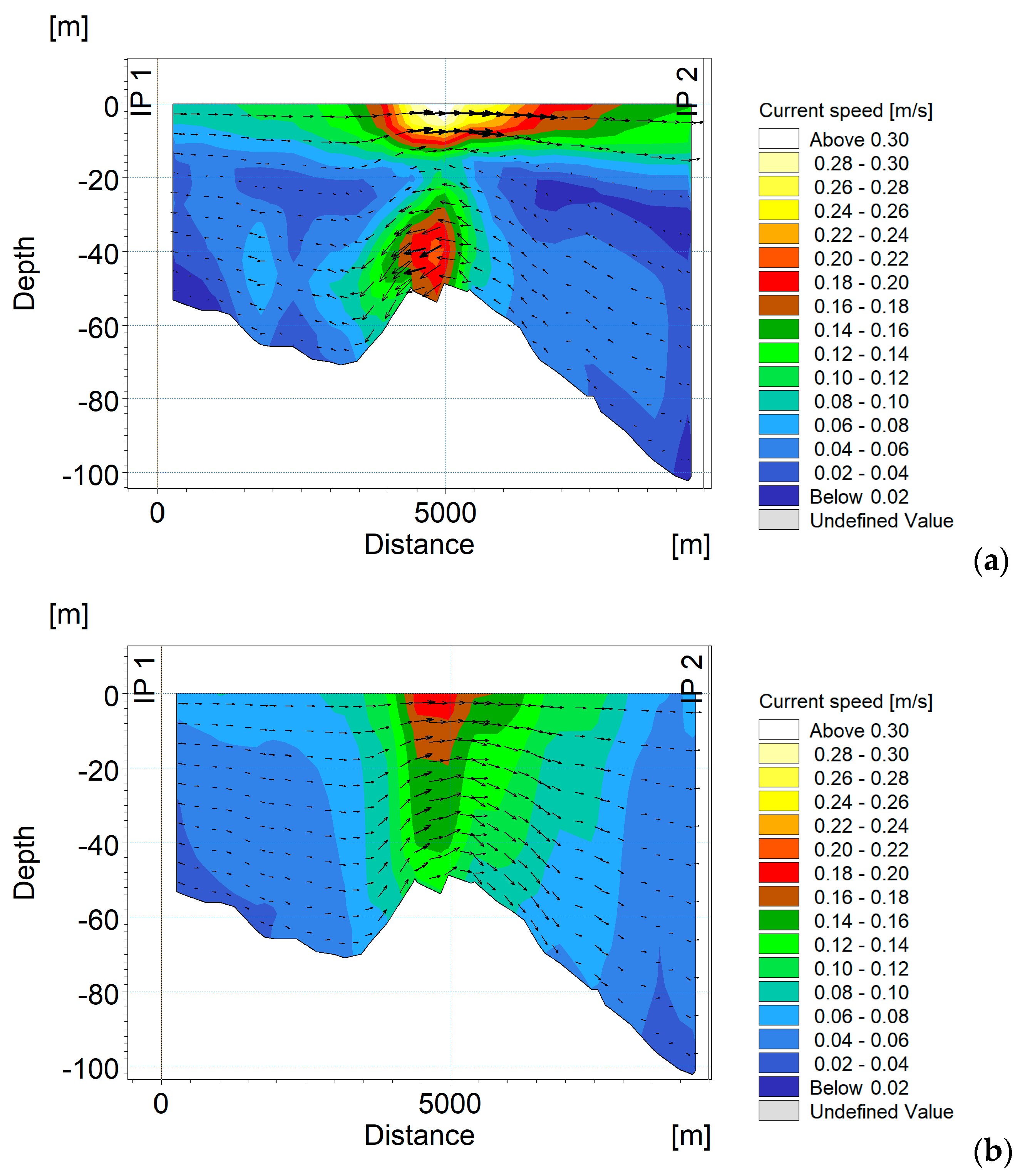
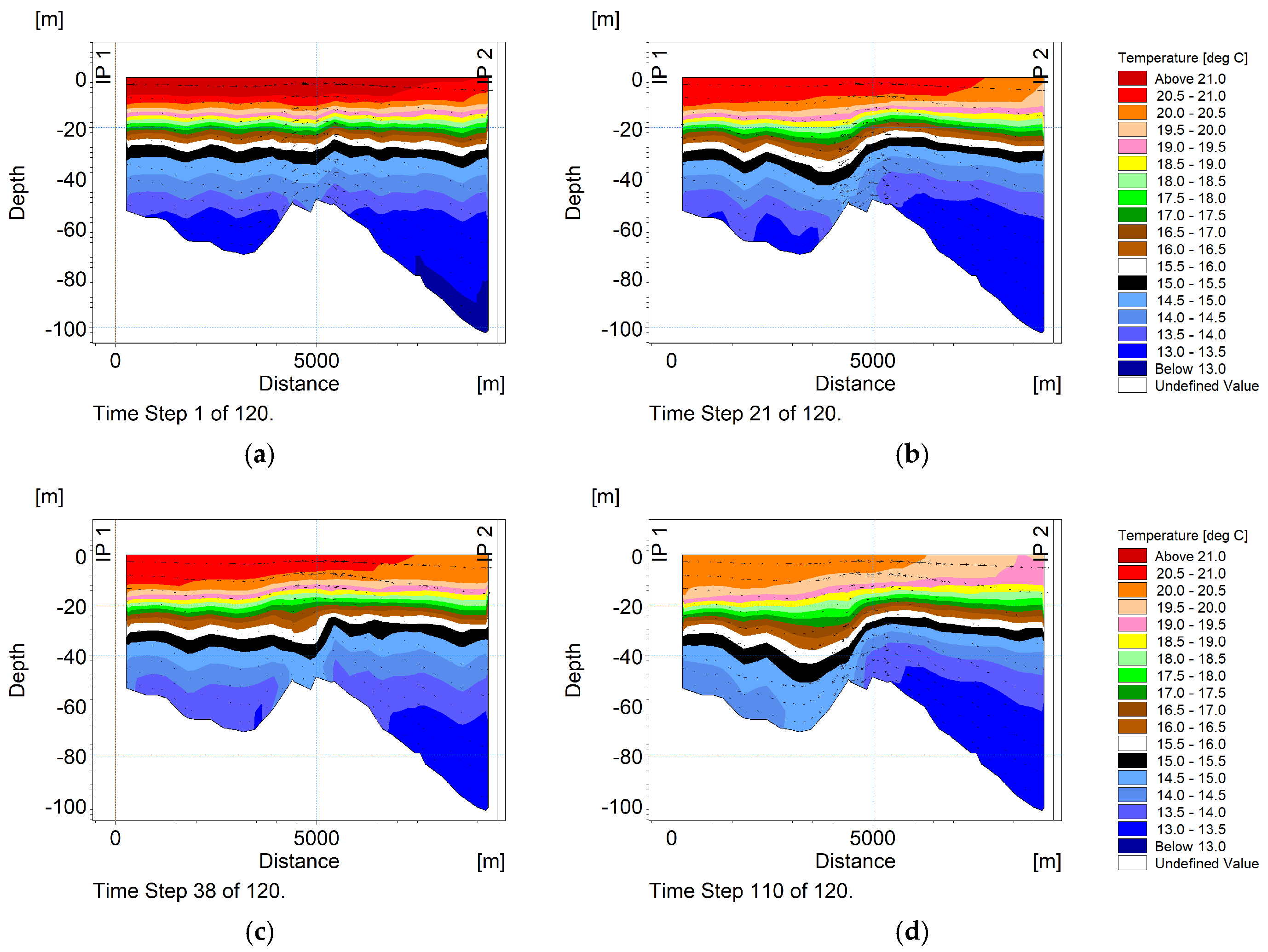

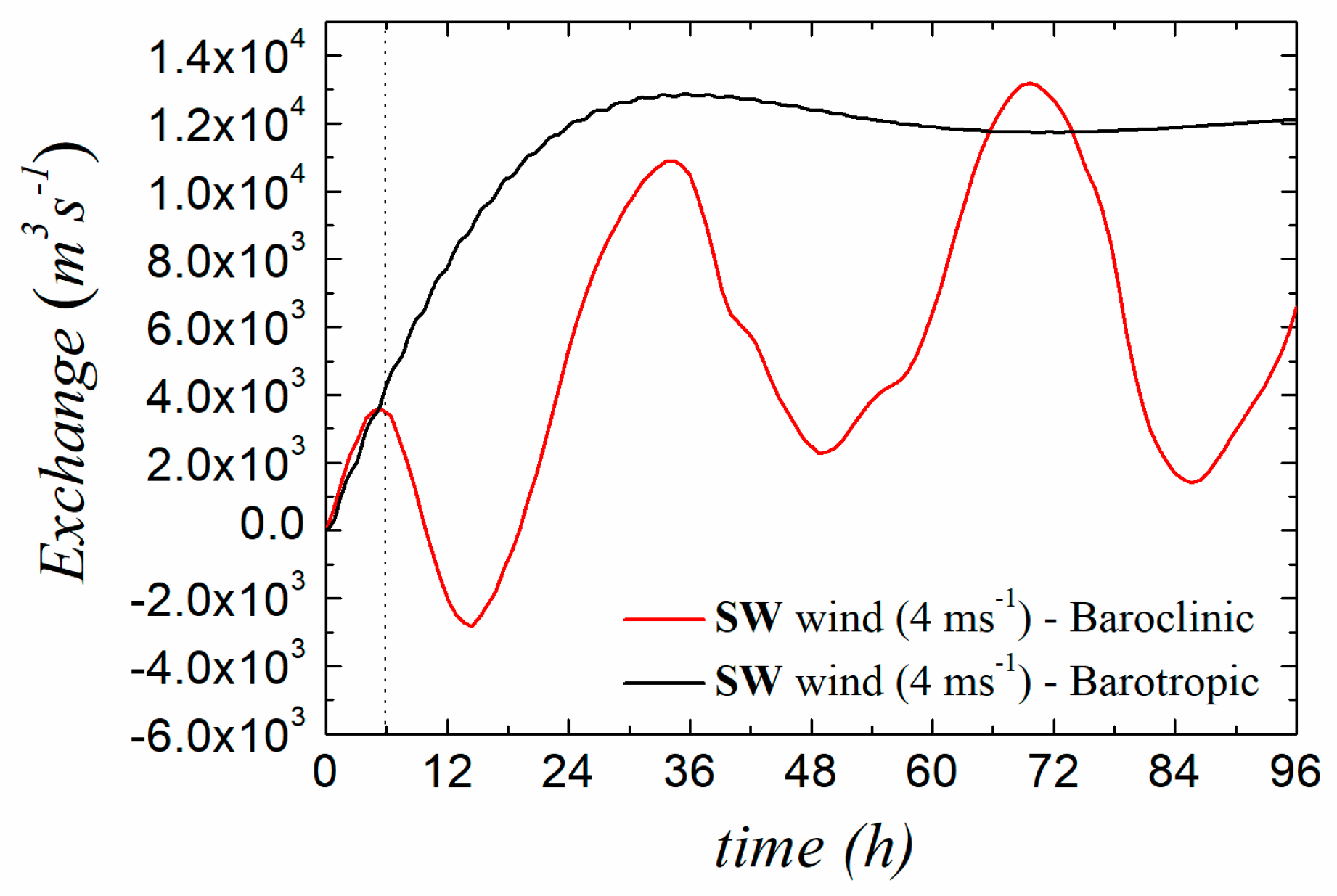

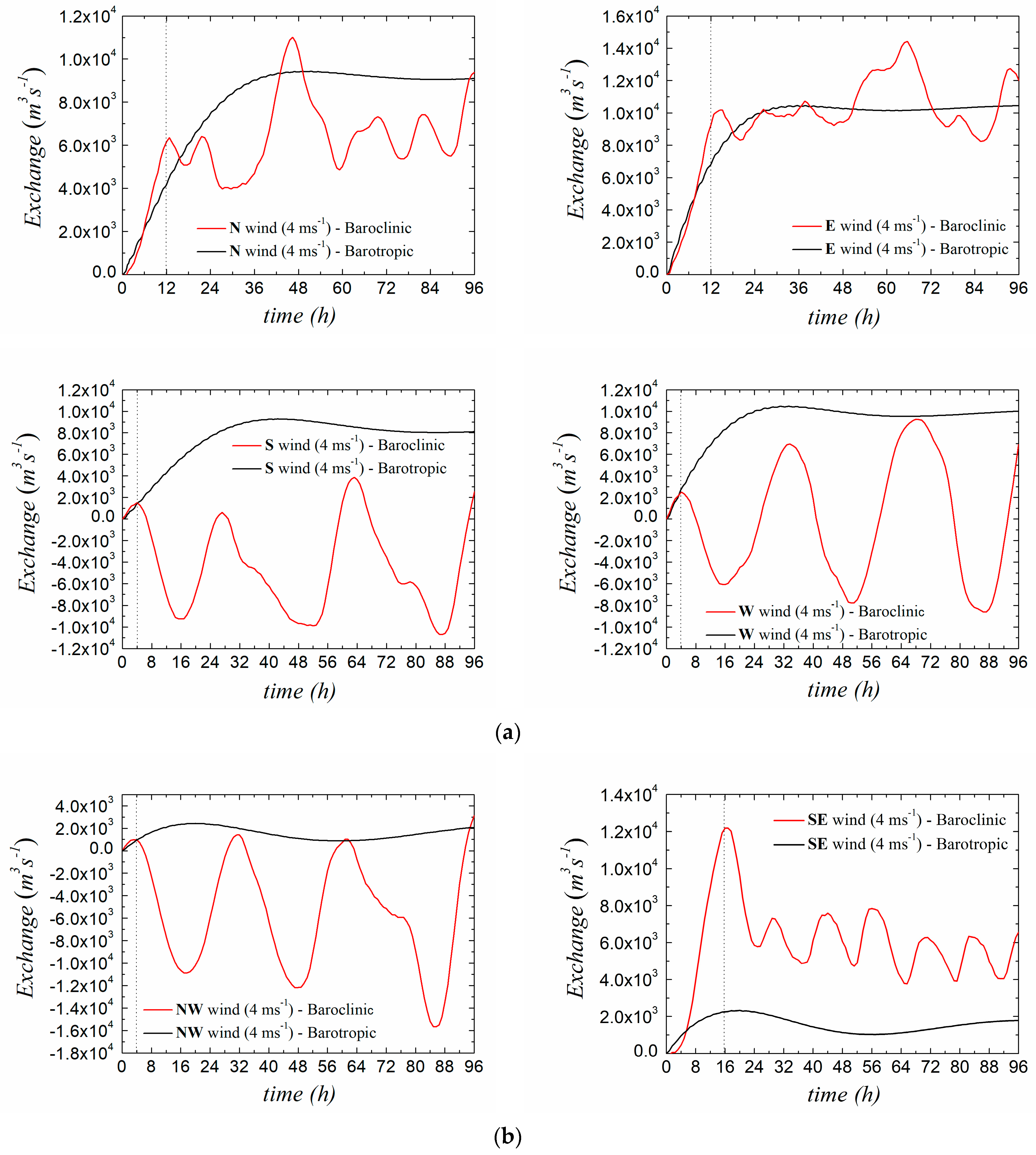


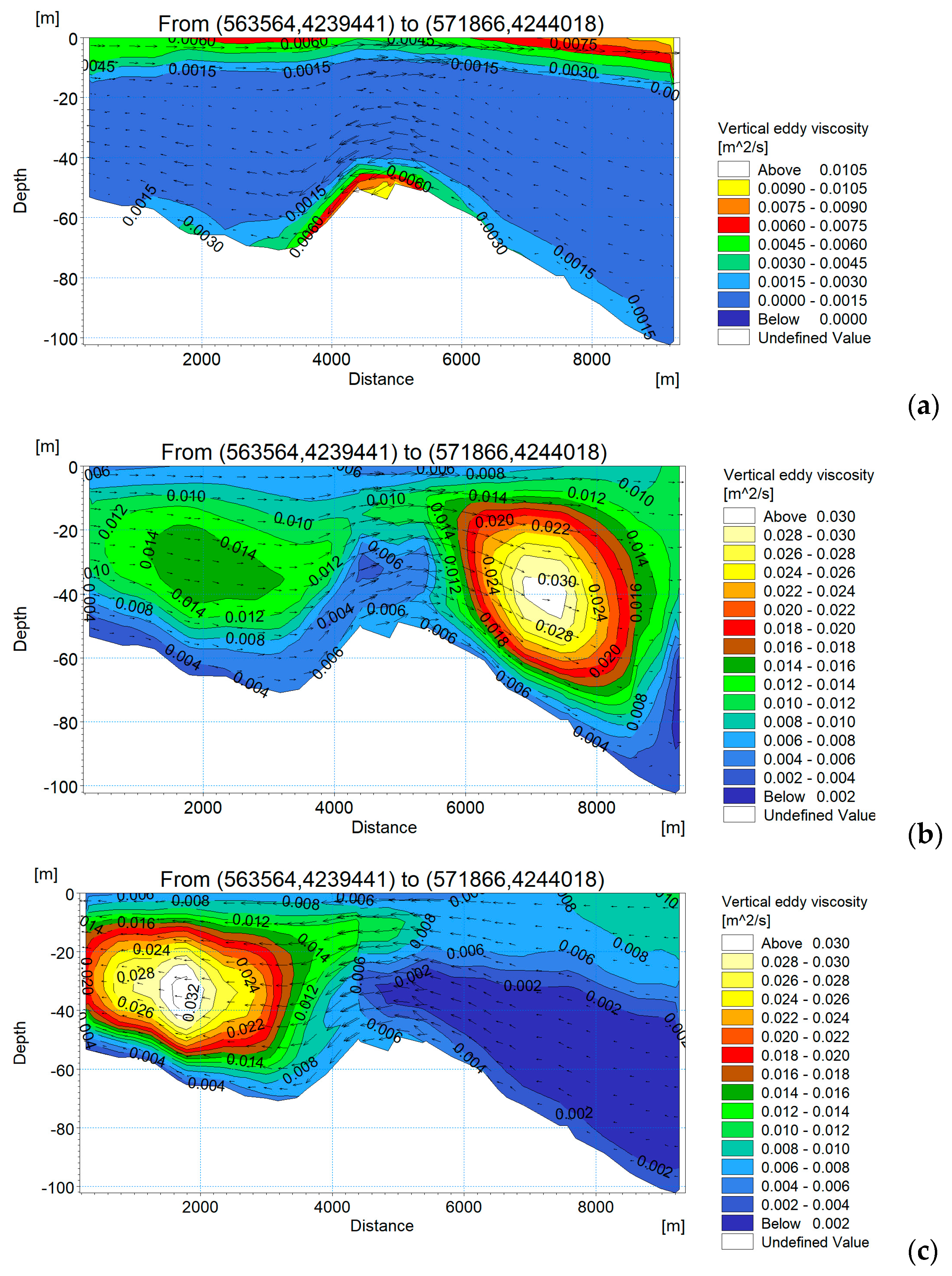
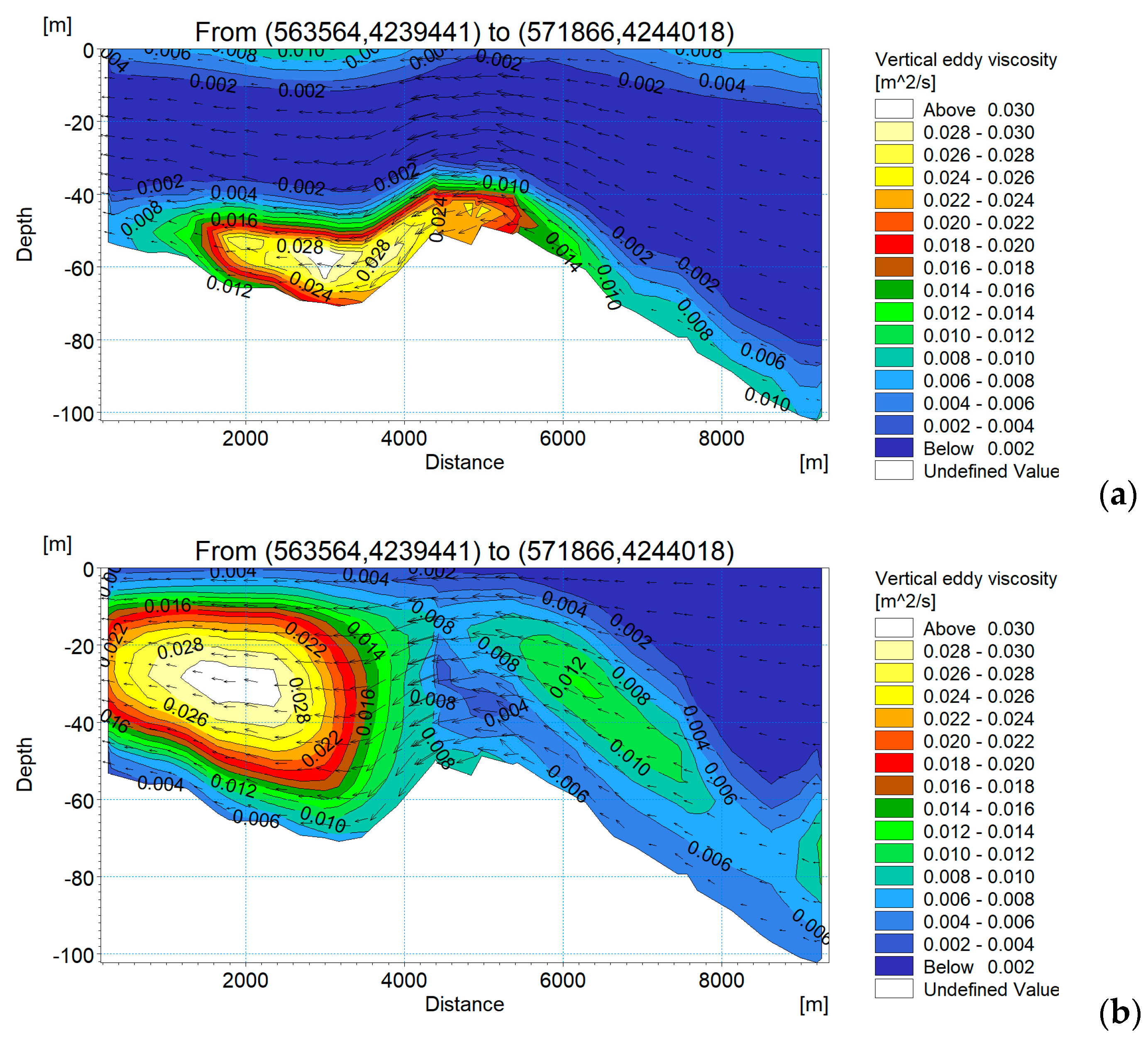
| Wind-Induced Circulation | Tide-Induced Circulation | ||
|---|---|---|---|
| Direction (4 m/s Wind) | Initiation of Internal Waves after Wind’s Onset (h) | Reversed Subsurface (Hypolimnetic) Flow | Reversed Subsurface (Hypolimnetic) Flow |
| N | 12 | √ | |
| NE | 48 | √ | |
| E | 12 | √ | |
| SE | 16 | √ | |
| S | 4 | √ | √ |
| SW | 6 | √ | √ |
| W | 4 | √ | √ |
| NW | 4 | √ | √ |
| Calm | - | - | √ |
Disclaimer/Publisher’s Note: The statements, opinions and data contained in all publications are solely those of the individual author(s) and contributor(s) and not of MDPI and/or the editor(s). MDPI and/or the editor(s) disclaim responsibility for any injury to people or property resulting from any ideas, methods, instructions or products referred to in the content. |
© 2024 by the author. Licensee MDPI, Basel, Switzerland. This article is an open access article distributed under the terms and conditions of the Creative Commons Attribution (CC BY) license (https://creativecommons.org/licenses/by/4.0/).
Share and Cite
Fourniotis, N.T. Effect of Internal Waves on the Hydrodynamics of a Mediterranean Sea Strait. J. Mar. Sci. Eng. 2024, 12, 532. https://doi.org/10.3390/jmse12040532
Fourniotis NT. Effect of Internal Waves on the Hydrodynamics of a Mediterranean Sea Strait. Journal of Marine Science and Engineering. 2024; 12(4):532. https://doi.org/10.3390/jmse12040532
Chicago/Turabian StyleFourniotis, Nikolaos Th. 2024. "Effect of Internal Waves on the Hydrodynamics of a Mediterranean Sea Strait" Journal of Marine Science and Engineering 12, no. 4: 532. https://doi.org/10.3390/jmse12040532





